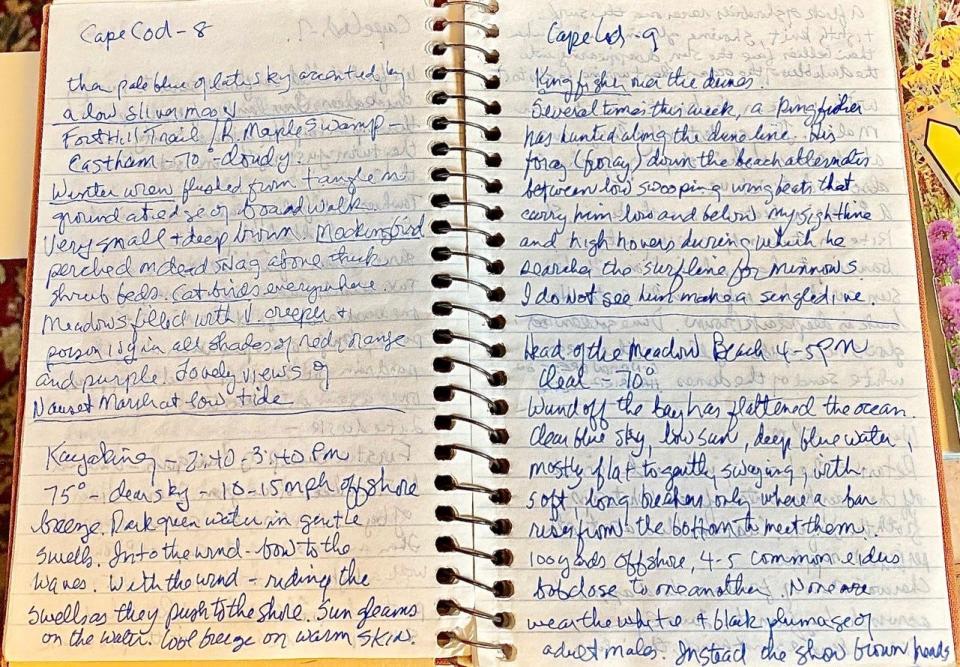Remembering this trip down Autumn Leaves Road: 2016 field journal
I keep harping on why it’s important to keep notes on what you observe out in nature.
If you don’t, in a month, you’ll forget almost all the details.
For decades, I wrote observations longhand in a pocket-sized reporter’s notebook. These days I dictate field notes into my smart phone. Returning home, I type the recorded observations into my computer, creating a file that includes location, date, year and weather conditions.
Between notebooks and computer files, I now possess hundreds of memory folders, encapsulating field trips enjoyed years ago.
Today, do you think — without having journal notes to refer to — I would remember what happened on a dirt road in rural northeastern Pennsylvania on April 19, 2016? The answer is no, not a chance.
But I did take notes, and — brushed up just a bit — here they are:

Field journal
April 19, 2016
Sunny - Winds NW at 15-25
Location: Autumn Leaves Road, Wayne Township, Pa.
Creeping along, we spy a northern flicker on grass by the side of the road. The black “mustache” of a male stands out clearly.
Also along the road: Last year’s beech tree leaves — now bleached almost as pale as marsh grass in late winter — still cling to smooth-barked twigs. Pussy willows are popping.
In wet spots, we note fronds of fiddlehead ferns poking out to enjoy springtime sun.
More: Outdoors lovers are easy to spot, just check their boots.
In fields, goldenrod galls on last fall’s brittle stalks catch our eye. Also there: milkweed pods, ashen-gray and wide open, their parachute seeds long dispersed.
Black willows blaze orange in early afternoon sun. Red-winged blackbirds honk-a-ree from the edge of overgrown field.
Bare roadside shrubs and saplings reveal last season’s nests. We stop to admire a goldfinch’s neatly woven cup, lined with thistle down.
In a brushy meadow, a field sparrow sings its bouncing ball song loud and clear from a young aspen’s peak. Then it moves to a perch on a weathered fence post that is cut through by rusted barbed wire.
More: Get familiar with your outdoor surroundings and find wonder in the smallest changes
Tree swallows dip over farm ponds, capturing insects too small to discern. Their backs glow as blue-green as the sun-splashed ponds rippling below them.
Painted turtles bask on semi-submerged logs jutting out from dense clumps of pond rushes. Detecting our presence, one turtle drops to the water like a bowling pin topples when struck. As we enter an intersection, incessant chattering overhead sounds like a dozen goldfinches conversing.
Keeping straight on Autumn Leaves Road, we pass by the yard of a paint-peeled farmhouse. There, an eastern bluebird perches on a garden bean pole, just a few feet from its chosen nest box. Bright blue on its back shouts out “male!”
Behind the house, a female kestrel streaks across a field of close-cropped grasses. No green shoots have emerged; just the wheat-straw remains of a meadow still looking like winter. Sleek and tawny, the she-falcon glides, swoops and soars. Then she veers when it looks like she’s spotted a vole or grasshopper.
Observations from this day continue for several more pages. But you get the point.
So many wonderful memories would have faded had I not kept some notes in a journal.
This article originally appeared on Binghamton Press & Sun-Bulletin: NY in spring: Why you should take a journal on your next trip outdoors